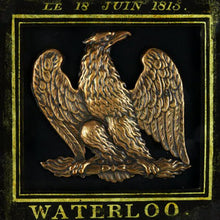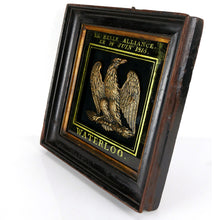Waterloo Relic - Old Guard Eagle Badge, Premier Empire, 1804
Adding product to your cart
Overall: 23.5cm (9.25) x 23cm (9in)
Embossed copper uncrowned French imperial eagle clutching Jupiter's spindle in its talons, as borne of the cartridge box or ‘giberne’ of a Grenadier-à-Pied de la Garde Impériale. Contained in an oak period frame bearing verso the trade frame maker’s label of William Wade 1800-1825 (fl. c.), No.86, Leadenhall Street, corner of Cree Church Lane, London, and a tantalising period manuscript label inscribed ‘ … taken …the … brought by …from the … after his … his executors. May 26th 1858.’ Contained in verre eglomisé and oak frame inscribed ‘La Belle Alliance / Le 18 Juin 1815. / Waterloo.’ Eagle badge: 10.7 cm x 10.6 cm.
Read more
The damaged manuscript label and the name ‘La Belle Alliance’, after the inn where Field Marshals Wellington and Blucher met at the conclusion of the battle, may suggest the original owner of this relic was a combatant if not an early tourist to the battlefield.
The Old Guard was created by Napoleon’s coronation decree of 29 July 1804. It comprised four regiments of infantry - 1st and 2nd each of grenadiers and chasseurs. Made up of experienced campaigners above average height, the Old Guard established a fearsome reputation. Disbanded in 1814 after an emotional farewell to the Emperor at Fontainbleau, the Old Guard was reformed on Napoleon's 1815 return from exile. At Waterloo the 2e Regiment de Grenadiers-à-Pied was pivotal in the defence of the village of Plancenoit against the Prussians. The 1er Regiment de Grenadiers protected the field position around Napoleon himself and served as a rearguard after the failure of the attack of the Middle Guard on the Allied centre.
The eagle badge is loaded with Napoleonic symbolism drawn from ancient Rome. Jupiter, god of the sky and thunder, was the chief deity of Roman state religion. The eagle was the symbol of Jupiter’s authority, and as such would be set free during the consecration of an emperor in a ritual that culminated in the emperor's apotheosis. By flying into the air, the eagle was believed to carry the soul of the deified emperor to heaven, thus securing him a place among the gods.






